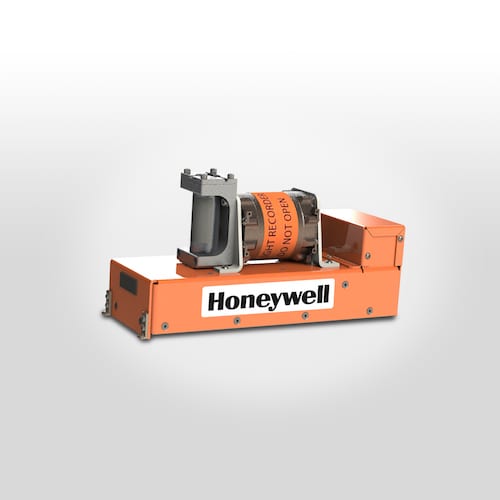
A mockup of the Honeywell Aerospace HCR-25 cockpit voice recorder. Photo: Honeywell Aerospace
Under a new agreement, Curtiss Wright and Honeywell Aerospace are developing a new generation of cockpit voice and flight data recorders, with the aim of bringing real-time data streaming and cloud upload functionality to the technology commonly referred to as “black boxes.”
The new agreement will make Curtiss Wright the exclusive supplier of Honeywell’s next-generation cockpit recorders for commercial airliners and business jets. One of the major goals of the new partnership is to develop new recorders that meet the European Aviation Safety Agency’s (EASA) new regulations requiring an extension of the minimum transmission times for Cockpit Voice Recorders (CVRs), Underwater Locating Devices (ULDs) and aircraft localization.
EASA first published the new requirements in 2016 requiring, among other things, CVRs featured on aircraft weighing more than 59,000 pounds to feature a minimum recording duration of 25 hours. Part of the requirements also took effect as of Jan. 1, 2019, including the replacement of recorders featuring magnetic tape with solid-state CVRs.
The two companies plan to offer the new recorders as standalone CVRs and Flight Data Recorders (FDRs), or as a combined voice and flight data recorder. Honeywell’s connected aircraft software will also enable real-time data streaming and cloud upload capabilities.
Going beyond meeting EASA’s 25-hour CVR recording requirement, which becomes effective in 2021, both companies also want operators to be able to access the data stored on their next-generation FDR. Both recorders will also become available as replacements of Honeywell’s existing HFR-5 series cockpit voice and flight data recorders.

HCR-25 flight data recorder. Photo: Honeywell Aerospace
“With today’s aircraft being increasingly more data rich than their predecessors, it seemed having the flight data stay on the aircraft waiting for an accident or incident to occur is somewhat older technology than it needs to be. Honeywell has the ability to connect recorders in the way that they traditionally function to outside world, where the operator can then have access to actionable information about their aircraft in real time,” Chris Thomson, vice president of the avionics division for Curtiss Wright told Avionics International.
Curtiss Wright first introduced major new design and functionality changes to its Fortress FDRs in 2017, adding new data link and image recording capabilities. There is also a new expansion slot on the recorder, internal data collection card and a remote USB interface so data from the Fortress can be directly downloaded to a laptop.
The FDR recently achieved a technical standard order, and is also featured on Irkut’s MC-21, which is currently undergoing a European and Russian flight testing certification campaign.
Honeywell’s overview of the HCR-25, the newly rebranded version of the Fortress under the Curtiss Wright and Honeywell partnership, states that it features four channels of “cockpit voice recording and CPDLC recording for up to 25 hours each.”
EASA’s decision to publish a regulatory 25 hour CVR mandate was the result of the findings of ICAO-lead working groups to develop new methods for making the data stored in CVRs and FDRs more readily available. The FAA has not published a 25 hour mandate yet for U.S.-based operators, although the National Transportation Safety Board (NTSB) recently made a strong call for them to do so within an October 2018 Air Canada Airbus A320 near miss investigation report.
“With the new regulatory requirement, we saw an opportunity to evolve our recorder technology to not only meet the conditions of governing agencies, but also make this product more powerful and better connected,” Ben Driggs, president of the services and connectivity division at Honeywell Aerospace, said of the new partnership.